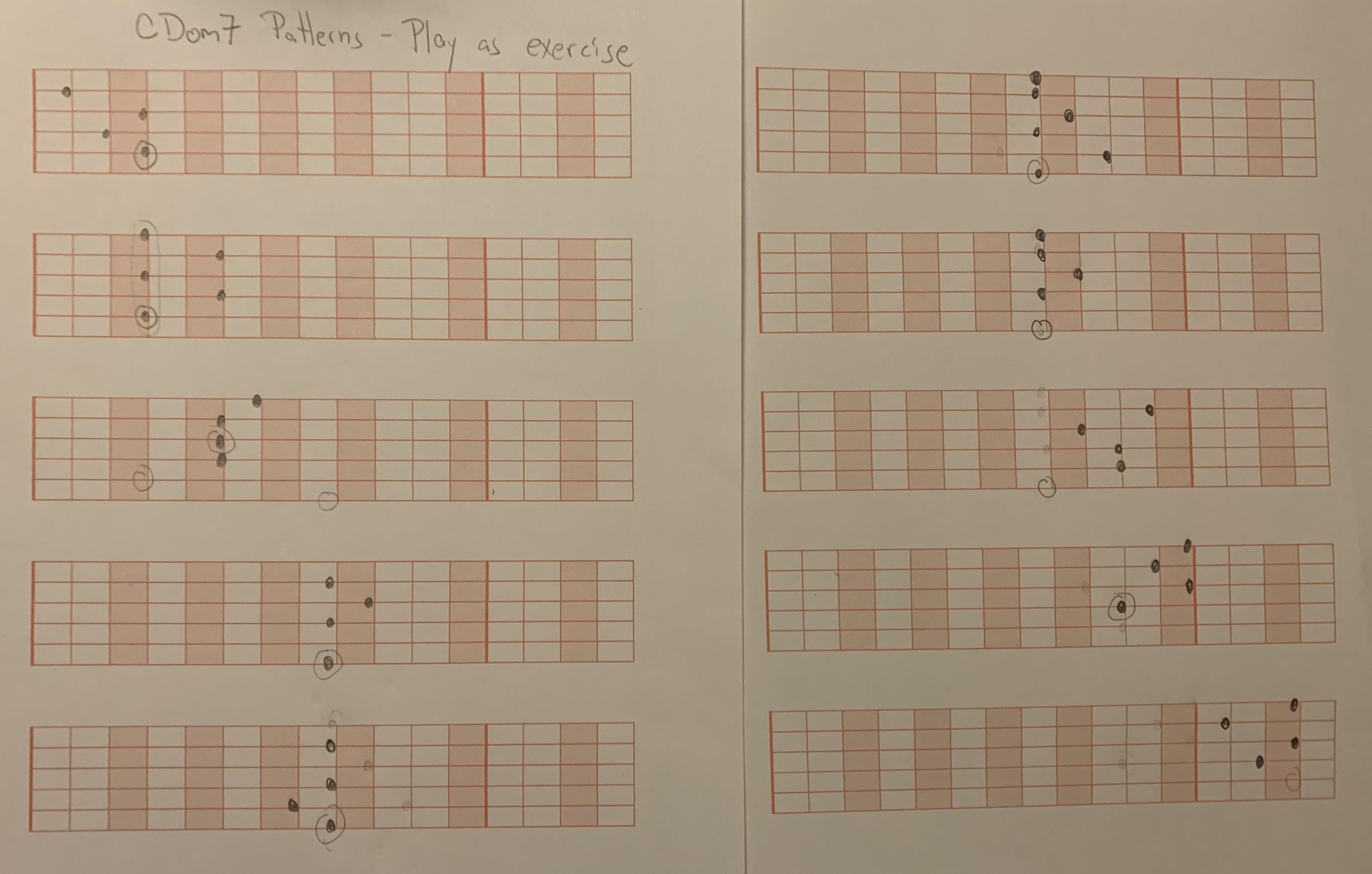I'm going over a video on dom7 chords. I've got well over a dozen, some of which are shown here. I'm wondering how to think about all these. Do most experienced players use all these in different situations, or is it more common to gravitate to a smaller handful of fingerings and voicings that feel comfortable or sound nicer to your ear? I know one would want to be able to cover a few different positions on the fretboard, and maybe as I start to become more of an intermediate player it will be important to have some different inversions. But some seem kind of redundant (like the 4th and 5th ones on the first page).
Alternate Fingerings/Voicings
As a rock player, I've only ever used #1 and #2 on Page 1 and #1 on Page 2 (and mostly the second two I just listed.) The reason is, they fit in well with typical major and minor barre chord shapes on the 5th and 6th strings. Meaning: for the 6th string F-shaped barre chord you just take off your pinky and you've got a Dom7. For the 5th string A-shaped barre chord you lift up your ring finger, and put your pinky down on the B string. Very easy to get to!
If you're going to get into jazz and more complex blues I'm sure all those other shapes would be useful to know.
-Carl.
Carl King[br]GuitarTricks Video Director / Producer
Originally Posted by: dlwalkeI'm going over a video on dom7 chords. I've got well over a dozen, some of which are shown here. I'm wondering how to think about all these.[/quote][p]Learn, practice & use them as you need them. As Carl noted he only uses certain dom7 chords & avoids others because as a mostly rock guitarist he has no need for the others.
Originally Posted by: dlwalkeDo most experienced players use all these in different situations, or is it more common to gravitate to a smaller handful of fingerings and voicings that feel comfortable or sound nicer to your ear?Yes all those & more are used in various situations by experienced players. But it all depends on the musical context.
If I'm playing blues by myself I might typically use some of the larger shapes including bass notes on the lower strings. But if I'm playing in band with a bass player & another guitarist then I might just play voicings of those chords only using the top 3 strings.
If I'm playing jazz, then I might use a bunch of inversions of those chords!
If I'm play funk or R&B then I'm definitely only using 3 string voicings on mostly the middle sets of strings.
[quote=dlwalke] I know one would want to be able to cover a few different positions on the fretboard, and maybe as I start to become more of an intermediate player it will be important to have some different inversions. But some seem kind of redundant (like the 4th and 5th ones on the first page).
The question is: what do you want to use them for? Time is finite & it's important to prioritize your learning & practice. Consider the style of music you want to play, which of those chord shapes is used in the songs you want to play.
If you can get by with 2 or 3 of those shapes, then that's great! Make sure you can play those really well, use them regularly. When you find a need to add another one of them to you vocabulary, then add it in the mix.
Hope this helps!
Thanks a bunch Chris and Carl. The best advice is specific and practical. You guys deliver.
FWIW, I have found the moveable (barred) E7 form, without the pinky on the B string, and the moveable C7 form to be the most comfortable and pleasing dom7 chords for me. Although I often am not so fond of the high-E string (except for single note melodies), I do love the simple (w/o the D string bass note) moveable D-shape. It's easy to add vibrato to the whole chord which, to my ear, often sounds nice (I think but am not sure that it interacts with movement from my floating vibrato bar in a curious way). I wish I liked the moveable A form more. I can play it OK but it usually feels a bit more awkward than the others...like it takes a bit longer to get into the position and requires more conscious intentionality for me to play it accurately. Typing this now, I'm thinking that I want to compare the barred version I usually play (the one using fingers 2 and 3) with the version where you play the 7th with your pinky on the high E string.
Take Care
You're welcome. Glad it helped.
Originally Posted by: dlwalkeFWIW, I have found the moveable (barred) E7 form, without the pinky on the B string, and the moveable C7 form to be the most comfortable and pleasing dom7 chords for me.[/quote][p]Sounds like you are making progress! If you
[quote=dlwalke]I do love the simple (w/o the D string bass note) moveable D-shape. It's easy to add vibrato to the whole chord which, to my ear, often sounds nice
That's a fun & useful shape. Once you get used to it you can move it to the E-A-D strings & the A-D-G strings where it makes the bottom of a C7 styled dom7 chord (1-maj3-min7 voicing).
You can also play it on the D-G-B strings but you have to move the B string note up one fret. Good stuff!